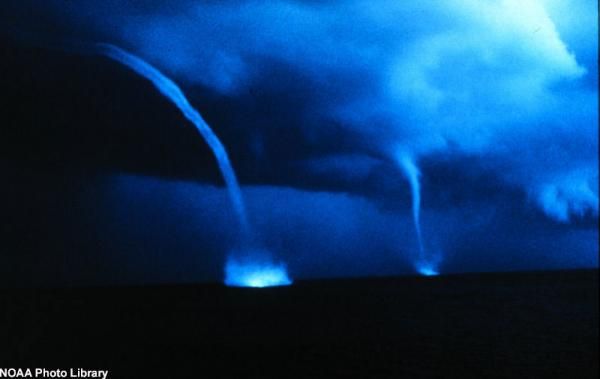
Five Tornadoes Strike Russia. Really?

Five tornadoes touched down about a mile offshore of the Russian port town of Novorossiysk at the same time in late August, according to Russian news reports. The storm was so frightening that police evacuated the town.
This may sound like an apocalyptic sci-fi flick, but these kinds of seemingly strange storms aren't all that rare.
"It's almost certainly real and not that uncommon," said Harold Brooks, an atmospheric scientist at the U.S. National Oceanic and Atmospheric Administration's National Severe Storms Laboratory in Norman, Okla., when asked about the plausibility of the reports.
The vast majority of Earth's tornadoes occur in Tornado Alley, where warm, moist Gulf of Mexico air collides with cool northern air, in the spring across the Midwest. But tornadoes can occur elsewhere and at other times of the year. There can even be winter tornadoes. Two struck northern Arizona yesterday, according to local news reports. New Jersey is thought to experience about three per year, according to data from the National Climatic Data Center. Many tornadoes are marginal in terms of wind speed and without photos, can be difficult to discern from strong thunderstorm winds.
In areas where intense funnel clouds commonly form over water (also known as waterspouts) the Florida Keys and the Adriatic Sea are two examples these storms will frequently form along a line of developing thunderstorms, Brooks told OurAmazingPlanet. They also occur over land in the right conditions.
The storm passed Novorossiysk without incident; no buildings were damaged and no people were injured, according to Prime Time Russia.
Extreme weather has been a theme for Russia this past summer, with deadly weather responsible for hundreds of deaths. Some in the country have pointed to climate change as the cause.
Sign up for the Live Science daily newsletter now
Get the world’s most fascinating discoveries delivered straight to your inbox.
Russia's summer heat wave, drought and wildfires, by themselves, are not signs of global warming, according to several leading climatologists despite widely reported claims this summer by a Russian scientist.
But experts agree that overall, the climate indeed shows signs of human-induced warming, and this type of weather may become more common in a warming world.
- The World's Weirdest Weather
- 7 Ways the Earth Changes in the Blink of an Eye
- Skyscraper Storms: 7 Big City Tornadoes












